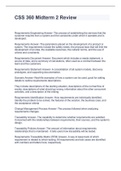Tentamen (uitwerkingen)
CSS 360 Midterm 2 Review
- Vak
- Instelling
Requirements Engineering Answer- The process of establishing the services that the customer requires from a system and the constraints under which it operates and is developed. Requirements Answer- The parameters placed on the development of a product or system. The requirements include the saf...
[Meer zien]




